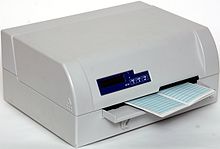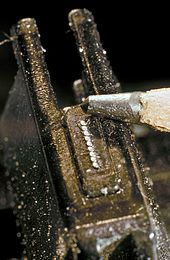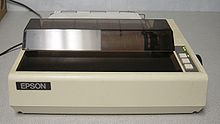This is an old revision of this page, as edited by Pi314m (talk | contribs) at 22:52, 17 October 2018 (→cart vs. horse). The present address (URL) is a permanent link to this revision, which may differ significantly from the current revision.
Revision as of 22:52, 17 October 2018 by Pi314m (talk | contribs) (→cart vs. horse)(diff) ← Previous revision | Latest revision (diff) | Newer revision → (diff)

Dot matrix printing is the process of computer printing from a collection of dot matrix data to a device, which can be one of:
- Impact dot matrix printers
- non-impact dot matrix printers, such as inkjet, thermal, or laser printers.
Impact dot matrix printing uses a print head that moves back-and-forth, or in an up-and-down motion, on the page and prints by impact, striking an ink-soaked cloth ribbon against the paper, much like the print mechanism on a typewriter. However, unlike a typewriter or daisy wheel printer, letters are drawn out of a dot matrix, and thus, varied fonts and arbitrary graphics can be produced.
These printers can print on multi-part (carbon paper) forms since they print using mechanical pressure.
The alternative to dot matrix printing is sometimes known as a letter-quality printer or a line printer which use fully formed type elements that impact a sheet of paper.
Dot-matrix impact printing
Dot matrix printing, sometimes called impact matrix printing, is a type of computer printing which uses a print head that moves back-and-forth, or in an up-and-down motion, on the page and prints by impact, striking an ink-soaked cloth ribbon against the paper, much like the print mechanism on a typewriter. However, unlike a typewriter or daisy wheel printer, letters are drawn out of a dot matrix, and thus, varied fonts and arbitrary graphics can be produced.
Although nearly all inkjet, thermal, and laser printers also print closely spaced dots rather than continuous lines or characters, it is not customary to call them dot matrix printers.

| Part of a series on the | ||||||||||||||||||||||||||||||||||||||||||||||||||||||||||||||
| History of printing | ||||||||||||||||||||||||||||||||||||||||||||||||||||||||||||||
|---|---|---|---|---|---|---|---|---|---|---|---|---|---|---|---|---|---|---|---|---|---|---|---|---|---|---|---|---|---|---|---|---|---|---|---|---|---|---|---|---|---|---|---|---|---|---|---|---|---|---|---|---|---|---|---|---|---|---|---|---|---|---|
 | ||||||||||||||||||||||||||||||||||||||||||||||||||||||||||||||
Techniques
|
||||||||||||||||||||||||||||||||||||||||||||||||||||||||||||||
Design
Each dot is produced by a tiny metal rod, also called a "wire" or "pin", which is driven forward by the power of a tiny electromagnet or solenoid, either directly or through small levers (pawls). Facing the ribbon and the paper is a small guide plate named ribbon mask holder or protector, sometimes also called butterfly for its typical shape. It is pierced with holes to serve as guides for the pins. The plate may be made of hard plastic or an artificial jewel such as sapphire or ruby.
The portion of the printer that contains the pin is called the print head. When running the printer, it generally prints one line of text at a time. There are two approaches to achieve this:


- The common serial dot matrix printers use a horizontally moving print head. The print head can be thought of featuring a single vertical column of seven or more pins approximately the height of a character box. In reality, the pins are arranged in up to four vertically or/and horizontally slightly displaced columns in order to increase the dot density and print speed through interleaving without causing the pins to jam. Thereby, up to 48 pins can be used to form the characters of a line while the print head moves horizontally.
- In a considerably different configuration, so called line dot matrix printers use a fixed print head almost as wide as the paper path utilizing a horizontal line of thousands of pins for printing. Sometimes two horizontally slightly displaced rows are used to improve the effective dot density through interleaving. While still line-oriented, these printers for the professional heavy-duty market effectively print a whole line at once while the paper moves forward below the print head.
The printing speed of serial dot matrix printers with moving heads varies from 30 to 1550 cps. In contrast to this, line matrix printers are capable of printing much more than 1000 cps, resulting in a throughput of up to 800 pages/hour.
Because the printing involves mechanical pressure, both of these types of printers can create carbon copies and carbonless copies.

These machines can be highly durable. When they do wear out, it is generally due to ink invading the guide plate of the print head, causing grit to adhere to it; this grit slowly causes the channels in the guide plate to wear from circles into ovals or slots, providing less and less accurate guidance to the printing wires. Eventually, even with tungsten blocks and titanium pawls, the printing becomes too unclear to read, a common problem when users failed to maintain the printer with regular cleaning as outlined in most user manuals.
A variation on the dot matrix printer was the cross hammer dot printer, patented by Seikosha in 1982. The smooth cylindrical roller of a conventional printer was replaced by a spinning, fluted cylinder. The print head was a simple hammer, with a vertical projecting edge, operated by an electromagnet. Where the vertical edge of the hammer intersected the horizontal flute of the cylinder, compressing the paper and ribbon between them, a single dot was marked on the paper. Characters were built up of multiple dots.
Early history
In 1925, Rudolf Hell invented the Hellschreiber, an early facsimile-like dot matrix-based teletypewriter device, patented in 1929.
Between 1952 and 1954 Fritz Karl Preikschat filed five patent applications for his teletype writer 7 stylus 35 dot matrix aka PKT printer, a dot matrix teletypewriter built between 1954 and 1956 in Germany. Like the earlier Hellschreiber, it still used electromechanical means of coding and decoding, but it used a start-stop method (asynchronous transmission) rather than synchronous transmission for communication. In 1956, while he was employed at Telefonbau und Normalzeit GmbH (TuN, later called Tenovis), the device was introduced to the Deutsche Bundespost (German Post Office), which did not show interest. When Preikschat emigrated into the USA in 1957 he sold the rights to utilize the applications in any countries (except for the USA) to TuN. The prototype was also shown to General Mills in 1957. An improved transistorized design became the basis for a portable dot matrix facsimile machine, which was prototyped and evaluated for military use by Boeing around 1966–1967.
The first non-impact dot matrix printer was marketed by IBM in 1957.
In 1968, the Japanese manufacturer OKI introduced its first serial impact dot matrix printer (SIDM), the OKI Wiredot. The printer supported a character generator for 128 characters with a print matrix of 7×5. It was aimed at governmental, financial, scientific and educational markets. For this achievement, OKI received an award from the Information Processing Society of Japan (IPSJ) in 2013.
In 1970 Digital Equipment Corporation (DEC) introduced an impact dot matrix printer, the LA30, as did Centronics (then of Hudson, New Hampshire): the Centronics 101. The search for a reliable printer mechanism led it to develop a relationship with Brother Industries, Ltd of Japan, and the sale of Centronics-badged Brother printer mechanisms equipped with a Centronics print head and Centronics electronics. Unlike Digital, Centronics concentrated on the low-end line printer marketplace with their distinctive units. In the process, they designed the parallel electrical interface that was to become standard on most printers until it began to be replaced by the Universal Serial Bus (USB) in the late 1990s.
Printer head positioning
The printer head is attached to a metal bar that ensures correct alignment, but horizontal positioning is controlled by a band that attaches to sprockets on two wheels at each side which is then driven with an electric motor. This band may be made of stainless steel, phosphor bronze or beryllium copper alloys, nylon or various synthetic materials with a twisted nylon core to prevent stretching. Actual position can be found out either by dead count using a stepper motor, rotary encoder attached to one wheel or a transparent plastic band with markings that is read by an optical sensor on the printer head (common on inkjets).
Uses
The hardware known as dot matrix printers, in the 1970s and 1980s, were generally considered the best combination of expense and versatility, and until the 1990s they were by far the most common form of printer used with personal and home computers.

Advantages and disadvantages
Dot matrix printers, like any impact printer, can print on multi-part stationery or make carbon-copies. Impact printers have one of the lowest printing costs per page. As the ink is running out, the printout gradually fades rather than suddenly stopping partway through a job. They are able to use continuous paper rather than requiring individual sheets, making them useful for data logging. They are good, reliable workhorses ideal for use in situations where low printing cost is more important than quality. The ink ribbon also does not easily dry out, including both the ribbon stored in the casing as well as the portion that is stretched in front of the print head; this unique property allows the dot-matrix printer to be used in environments where printer duty can be rare, for instance, as with a Fire Alarm Control Panel's output.
Impact printers create noise when the pins or typeface strike the ribbon to the paper, and sound-damping enclosures may have to be used in quiet environments. They can only print lower-resolution graphics, with limited color performance, limited quality, and lower speeds compared to non-impact printers. While they support fanfold paper with tractor holes well, single-sheet paper may have to be wound in and aligned by hand, which is relatively time-consuming, or a sheet feeder may be utilized which can have a lower paper feed reliability. When printing labels on release paper, they are prone to paper jams when a print wire snags the leading edge of the label while printing at its very edge. For text-only labels (e.g. mailing labels), a daisy wheel printer or band printer may offer better print quality and a lower risk of damaging the paper.
The advantages are: low purchase cost, can handle multipart forms, cheap to operate, only needs fresh ribbons, rugged, low repair cost and the ability to print on continuous paper. This makes it possible to print long banners that span across several sheets of paper.
The disadvantages are: noisy, low resolution (dots making up each character are visible), not all can do color, color looks faded and streaky, slowness and more prone to jamming - with jams that are more difficult to clear. This is because paper is fed in using two sprockets engaging with holes in the paper. A small tear on the side of a sheet can cause a jam, with paper debris that is tedious to remove.
See also
- Daisy wheel printing
- Dye-sublimation printer
- IBM Proprinter
- Line printer
- Printer (computing)
- Thermal printer
- Typeball printer
- ESC/P
References
- The New York Times calls it "dot-matrix impact printers."Peter H. Lewis (December 17, 1985). "Getting the most out of a dox matrix printer". The New York Times.
- ^ "Dot Matrix vs. Inkjet". YourBusiness.AZcentral.com.
Dot matrix and inkjet printers share one key characteristic -- both make images out of small dots. With a dot matrix printer, a pin presses through a ribbon to make an impact on the page. Inkjet printers have an electrical signal that causes a microscopic quantity of ink to squirt onto the page.
- "A+ Chapter 11 Flashcards".
print head has row of pins, which are triggered in patterns that form letters and ... printer head carriage is the part that moves back and forth during printing
- "10 Rules You Should Know To Keep Your Dot Matrix Printer Operational" (PDF). MicomData.com.
Serial Dot Matrix Printer – a type of Dot Matrix Printer in which the printhead moves in the horizontal direction, the printhead controller sends electrical ... lubricant on the moving parts of this machine, normally on the shaft ...
- "Dot Matrix printers". MindMachine.co.uk.
... as many as 48 pins. ... The pins in a dot-matrix printer are quite light, and can therefore move fast
- "Dot Matrix Printing is defined here as a labelling term".
In a line dot matrix, the printhead is as wide as the substrate and is fixed in place
- DEC LA30
- Epson DFX-9000 https://www.epson.de/products/printers/dot-matrix-printers/epson-dfx-9000#specifications Archived 2016-05-05 at the Wayback Machine
- Patent US4462705 Cross hammer dot printer, Google Patents, accessed 2013-10-01
- ^ Preikschat, Fritz Karl (2016) , Working papers on dot matrix teletypewriter (PDF), archived from the original (PDF) on 2016-10-31, retrieved 2016-10-31,
A well-known machine representative of the dot-matrix type of teletypewriter was the "Hell" (name of designer) teletypewriter, developed about 1930 and used prior to and during the Second World War by the German Army.
The "Hell" printer was extremely simple and reliable. Because of the narrow bandwidth requirements, it was capable of transmitting and receiving legible characters over telephony circuits considered unusable for voice transmissions because of the high noise level. However, a serious disadvantage of the machine was that it required synchronous transmission. With this type of transmission, transmitting and receiving machines operated in step and continuously. The operator had to touch the keys at the proper moment, and every lost time unit caused a space in the received print.
The PKT printer, developed in 1954–1956, was an outgrowth of the "Hell" printer. The PKT printer continued the use of electromechanical means of coding, decoding, and printing the characters on a tape or a page of paper, but did away with the need for synchronous transmission; using instead a start-stop method. While the start-stop method does require higher quality transmission links than synchronous method, since a noise pulse could be taken for a start pulse, the advantages far outweight the slight increase in bandwidth required.
While the PKT printer was considerable smaller and lighter than the "Hell" printer, the majority of the space and weight were devoted to mechanical apparatus necessary for operation.{{citation}}: Unknown parameter|dead-url=ignored (|url-status=suggested) (help) - DE patent 1006007, Preikschat, Fritz Karl, "Umschalteinrichtung für Fernschreiber, bei dem die Schriftzeichen in Rasterpunkte zerlegt sind", issued 1957-09-12, assigned to Telefonbau und Normalzeit G.m.b.H.
- DE application 1006007B, Preikschat, Fritz Karl, "Umschalteinrichtung fuer Fernschreiber, bei dem die Schriftzeichen in Rasterpunkte zerlegt sind", published 1957-04-11, assigned to Preikschat, Fritz Karl
- ^ Telefonbau und Normalzeit GmbH; Preikschat, Fritz Karl (1957-05-31), Letter of TELEFONBAU and NORMALZEIT G.M.B.H. to Mr. Fritz Preikschat (PDF) (Contract) (in German and English), Frankfurt am Main, Germany, archived from the original (PDF) on 2016-10-29, retrieved 2016-10-29,
1) Patent 8101 Klasse 21a1, Gruppe 17, Anmeldetag: 29.7.1952, Fernschreiber ; 2) Patent 15749 Klasse 21a1, Gruppe 7/01, Anmeldetag: 29.7.1952, Umschalteinrichtung für Fernschreiber, bei dem die Schriftzeichen in Rasterpunkte zerlegt sind ; 3) Patent 15759 Klasse 21a1, Anmeldetag: 29.7.1952, Schreibkopf für Raster-Fernschreibmaschine ; 4) Patent 9043 Klasse 21a1, Anmeldetag 17.1.1953, Fernschreiber ; 5) Patent 12196 Klasse 21a1, Anmeldetag 24.6.1954, Schreibkopf für Fernschreibmaschine
{{citation}}: Unknown parameter|dead-url=ignored (|url-status=suggested) (help)CS1 maint: location missing publisher (link) (8 pages) - Dot matrix teletypewriter prototype photos for General Mills (PDF), 2016 , archived from the original (PDF) on 2016-10-31, retrieved 2016-10-31
{{citation}}: Unknown parameter|dead-url=ignored (|url-status=suggested) (help) - Facsimile transponder prototype at Boeing (PDF), 2016 , archived from the original (PDF) on 2016-10-31, retrieved 2016-10-31
{{citation}}: Unknown parameter|dead-url=ignored (|url-status=suggested) (help) - Drawings of portable fax machine for Boeing (PDF), 2016 , archived from the original (PDF) on 2016-10-31, retrieved 2016-10-31
{{citation}}: Unknown parameter|dead-url=ignored (|url-status=suggested) (help) - "History of Computer Printers".
- Mary Brandel (May 12, 1999). "1957: IBM introduces the first dot-matrix printer".
- "Information Processing Technology Heritage - Wiredot printer". Information Processing Society of Japan (IPSJ). 2012. Archived from the original on 2016-10-31. Retrieved 2016-10-31.
{{cite web}}: Unknown parameter|dead-url=ignored (|url-status=suggested) (help) - "OKI's Wiredot Printer Receives Information Processing Technology Heritage Certification in Japan". Mount Laurel, New Jersey, USA. 2013-03-14. Retrieved 2016-10-31.
- "OKI Printer aus 1968 als technologisch wertvolles Erbe ausgezeichnet" (in German). 2013-03-26. Archived from the original on 2016-10-31. Retrieved 2016-10-31.
{{cite web}}: Unknown parameter|dead-url=ignored (|url-status=suggested) (help) - Webster, Edward C. (2000). Print Unchained: Fifty Years of Digital Printing: A Saga of Invention and Enterprise. West Dover, VT: DRA of Vermont. ISBN 0-9702617-0-5.
- "MX-70 - User Manual" (PDF). epson.com.
- "Panasonic KX-P2123. (dot-matrix printer) (Hardware Review) (Evaluation)".